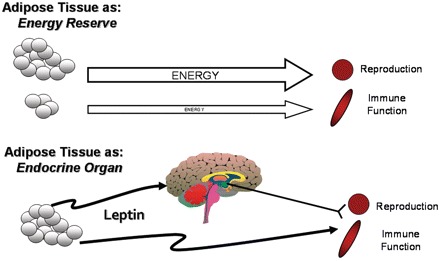Fig. 1.

Proposed mechanisms for energetic trade-offs between reproduction and immune function. In the top panel, energy is invested in physiological functions, including reproduction (represented by gonad), and immune function (represented by spleen). The degree of energetic investment is directly dependent on the amount of available energy. The bottom panel represents an alternative mechanism by which trade-offs are coordinated via the use of an endocrine signal, in this case leptin. In this scenario, rather than energy directly affecting reproduction or immune function, leptin provides a signal of available energy; specific physiological functions are then modified via the relative presence or absence of the leptin signal. Further, leptin can act directly on reproductive and lymphoid tissues or indirectly via the central nervous system (brain) to regulate physiological trade-offs.
